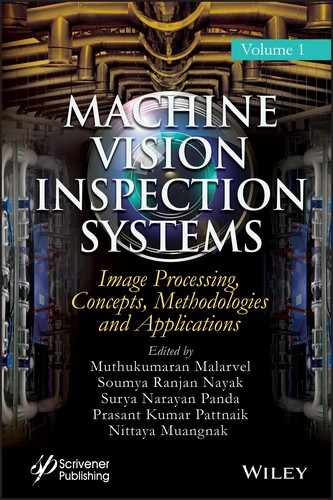Book Description
This edited book brings together leading researchers, academic scientists and research scholars to put forward and share their experiences and research results on all aspects of an inspection system for detection analysis for various machine vision applications. It also provides a premier interdisciplinary platform to present and discuss the most recent innovations, trends, methodology, applications, and concerns as well as practical challenges encountered and solutions adopted in the inspection system in terms of image processing and analytics of machine vision for real and industrial application.
Machine vision inspection systems (MVIS) utilized all industrial and non-industrial applications where the execution of their utilities based on the acquisition and processing of images. MVIS can be applicable in industry, governmental, defense, aerospace, remote sensing, medical, and academic/education applications but constraints are different. MVIS entails acceptable accuracy, high reliability, high robustness, and low cost. Image processing is a well-defined transformation between human vision and image digitization, and their techniques are the foremost way to experiment in the MVIS. The digital image technique furnishes improved pictorial information by processing the image data through machine vision perception. Digital image processing has widely been used in MVIS applications and it can be employed to a wide diversity of problems particularly in Non-Destructive testing (NDT), presence/absence detection, defect/fault detection (weld, textile, tiles, wood, etc.,), automated vision test & measurement, pattern matching, optical character recognition & verification (OCR/OCV), barcode reading and traceability, medical diagnosis, weather forecasting, face recognition, defence and space research, etc. This edited book is designed to address various aspects of recent methodologies, concepts and research plan out to the readers for giving more depth insights for perusing research on machine vision using image processing techniques.
Table of Contents
- Cover
- Preface
- 1 Land-Use Classification with Integrated Data
- 2 Indian Sign Language Recognition Using Soft Computing Techniques
- 3 Stored Grain Pest Identification Using an Unmanned Aerial Vehicle (UAV)-Assisted Pest Detection Model
- 4 Object Descriptor for Machine Vision
- 5 Flood Disaster Management
- 6 Temporal Color Analysis of Avocado Dip for Quality Control
- 7 Image and Video Processing for Defect Detection in Key Infrastructure
- 8 Methodology for the Detection of Asymptomatic Diabetic Retinopathy
- 9 Offline Handwritten Numeral Recognition Using Convolution Neural Network
- 10 A Review on Phishing—Machine Vision and Learning Approaches
- Index
- End User License Agreement
